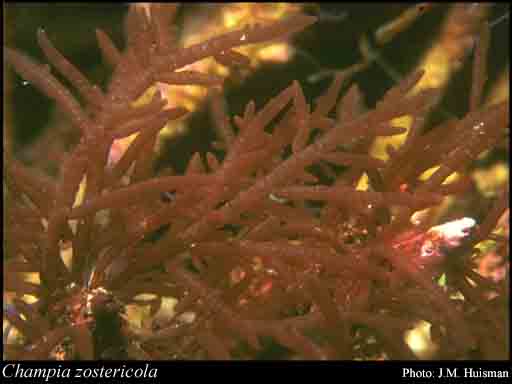- Reference
- Trans.Roy.Soc.South Australia 87 (1976)
- Conservation Code
- Not threatened
- Naturalised Status
- Native to Western Australia
- Name Status
- Current

Scientific Description
Habit and structure. Thallus grey-red to medium red, forming irregular spreading clumps 6–20 cm high, with one to several erect axes or main branches from an entangled base. Branching irregularly radial, main branches terete, 1.5–3(–5) mm in diameter, laterals only slightly slenderer, branchlets 0.5–2 mm in diameter, slightly basally constricted, apices rounded, young and mid branches constricted at diaphragms (which are distinct throughout), less so in oldest parts; mature plants with some to many branches ending in recurved tips. Holdfasts small, discoid, or as multicellular pads; epiphytic on seagrasses (Posidonia, Heterozostera and Amphibolis) or epilithic(?). Structure multiaxial with peripheral initials, developing a single-layered cortex of relatively large angular cells 40–60(–75) µm across and mostly (1.5–)2–4 times as long as broad, arranged more-or-less in longitudinal rows with most cutting off a small corner cell when young and further such cells when older, but maintaining an essentially single-layered cortex; longitudinal filaments peripheral only (rarely with odd ones more centrally), with one complete cell (with a secretory cell) and two half cells between the monostromatic diaphragms. Rhodoplasts discoid, in chains or ribbon like in older cells.
Reproduction. Gametangial thalli dioecious. Carpogonial branches 4-celled, borne on a cortical cell together with a 2-celled auxiliary cell branch. Carposporophyte erect, with a basal fusion cell, branched ovoid-celled gonimoblast filaments and terminal ovoid to obconical carposporangia 20–40 µm in diameter; basal nutritive tissue slight, erect filaments of stellate cells. Cystocarps scattered, subspherical to slightly conical, 0.7–1 mm in diameter; pericarp 90–160 µm and 2–4 cells thick, inner cells stellate and separating, ostiolate. Spermatangia in sori, often collar like, on smaller branches, cut off from chains of initials derived from the cortical cells, elongate, 2–4 µm in diameter. Tetrasporangia scattered, transformed form cortical cells, 60–100 µm in diameter, tetrahedrally divided.
Distribution.Houtman Abrolhos, W. Aust., to Port Stephens, N.S.W., and around Tas.
Habitat. C. zostericola is a common species in regions of moderate water movement, usually epiphytic on Amphibolis, Posidonia and Heterozostera, from shaded shallow areas to 40 m deep.
[After Womersley, Mar. Benthic Fl. Southern Australia IIIB: 127–129 (1996)]
Distribution
- IBRA Regions
- Esperance Plains, Geraldton Sandplains, Swan Coastal Plain.
- IBRA Subregions
- Geraldton Hills, Perth, Recherche.
- IMCRA Regions
- Central West Coast, Leeuwin-Naturaliste.
- Local Government Areas (LGAs)
- Coorow, Dandaragan, Esperance, Greater Geraldton, Irwin, Rockingham, Wanneroo.